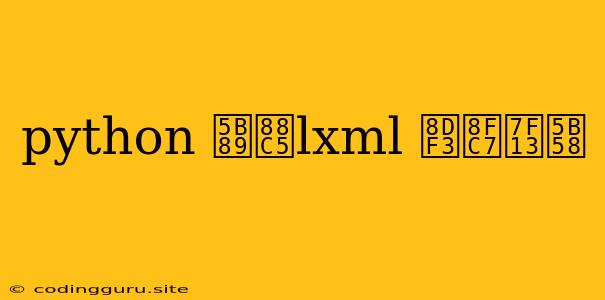How to Install lxml in Python and Bypass Cache
The lxml library is a powerful and efficient Python library for processing XML and HTML data. It provides fast parsing, validation, and manipulation capabilities, making it a go-to choice for many Python developers working with web scraping, data extraction, and more.
However, installing lxml can sometimes be a bit tricky, especially if you're encountering caching issues. This article will guide you through the process of installing lxml in Python and bypassing any potential cache problems.
Understanding the Issue
When you try to install lxml using pip, the package manager might attempt to retrieve it from a local cache. This cache can sometimes contain outdated or corrupted versions of the library, leading to installation errors.
Troubleshooting the Cache
Here's how to troubleshoot the cache issue and ensure a successful lxml installation:
- Clear the Cache:
- Run the following command in your terminal to clear the pip cache:
pip cache purge
- Run the following command in your terminal to clear the pip cache:
- Update pip:
- It's always good practice to make sure you're using the latest version of pip. Update it using:
python -m pip install --upgrade pip
- It's always good practice to make sure you're using the latest version of pip. Update it using:
- Try Again:
- After clearing the cache and updating pip, try installing lxml again:
pip install lxml
- After clearing the cache and updating pip, try installing lxml again:
Bypass Caching During Installation
If the cache problem persists, you can bypass it completely using the following methods:
- Specifying the Installation Source:
- You can explicitly specify the source for the lxml package using the
--no-cache-dirflag:pip install --no-cache-dir lxml
- You can explicitly specify the source for the lxml package using the
- Force Reinstallation:
- You can force lxml to be reinstalled from scratch by using the
--force-reinstallflag:pip install --force-reinstall lxml
- You can force lxml to be reinstalled from scratch by using the
Installing lxml from Source
In some rare cases, you might need to install lxml from its source code. This involves compiling the library from scratch and can be a bit more involved but can be necessary for specific platform configurations or if you require a specific version of the library.
- Download the Source Code:
- Download the latest lxml source code from the official project website.
- Install Dependencies:
- Install the necessary dependencies required to build lxml, which often include:
- libxml2 and libxslt (XML and XSLT libraries)
- Python Development Headers
- Install the necessary dependencies required to build lxml, which often include:
- Configure and Build:
- Use the
configurescript andmakecommands to configure and build the library. - Follow the instructions provided in the lxml documentation for detailed steps.
- Use the
- Install:
- Use the
make installcommand to install lxml in your Python environment.
- Use the
Important Considerations:
- Dependencies: Make sure your system has all the required dependencies, including libxml2, libxslt, and Python Development Headers.
- Compilers: If you're installing from source, you need a suitable C compiler (like GCC) on your system.
Conclusion
Installing lxml can sometimes be affected by caching issues. By clearing the cache, updating pip, and using the --no-cache-dir or --force-reinstall flags, you can bypass these problems and successfully install the lxml library. In rare cases, you might need to install lxml from source, but the methods outlined above should resolve most installation issues.
